TAKEAWAY: Today I start the series 40 Years/40 Lessons, which I call a “sort of career memoir” capturing highlights and reminiscing about what has been a spectacular journey for me, doing what I love most. Today’s segment: Taking a look in that mirror and letting it talk back to you. The series will run from time to time until February 2011.
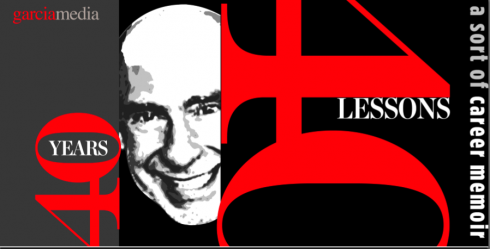

I have often thought that 40 is a decisive age in the life of humans.
It is the one life marker which we all use to look in that tall mirror in front of us, give ourselves a good up and down check, then try to open our heads( and hearts) to see what’s in them. The questions then pour forth: what’s next? how is my life progressing? what should the next 10 years be like?
Professionally, it is perhaps the earliest appropriate moment to face your reality. While not abandoning dreams——one never truly does at any age——this confrontation between us and the mirror is like sipping from that martini of reality that tells us if we should cancel old goals and create new ones then forge ahead emphasizing our strengths, while becoming aware of our weaknesses.
I strongly believe that at 40, many people face themselves in an honest way and say things out loudly.
“No, I am not going to be the lead singer in a Broadway musical.”
“No, I am not going to be the next Serena Williams or Justin Timberlake or Tom Hanks.”
“But, I will be a good singer with constant work on Broadway productions, or I will play tennis professionally, or get secondary meaty roles on films—-or in community theater.”
Those who face their own reality at 40 are less likely to end up in therapy than those who look in that unforgiving mirror, don’t like what the mirror reveals, and continue on a path to the impossible. There is a distinct difference between setting goals and pursuing them and proceeding stubbornly insisting to do things at which we could never succeed.
At 40 it is a good time for us to pack the suitcase of life with our strengths, add a little bag of humility and leave a bit of space for some delicious serendipity.
Nothing can be sadder than to find yourself believing that you are what you are not, that you have skills and talents that you don’t, and going thru life with the frustrations that such wrong self appraisals may produce. More than sad, it is painful for these people.
The role models
I know, as I have met them: the wonderful artist who ascended into management, but could not manage anything, or the editor who thought he was a designer, or the art director who thought he could excel at all aspects of the craft (but, truly, can anyone?) and no longer needed to hear what other designers had to say.
The happiest, most successful and productive people I have met in my 40-year career are those who knew who they were. They normally had great awareness of their strengths (which they utilized with gusto) ,as well as their weaknesses (which they used as engines formulating the good questions while getting the expertise of others). They became my role models.
Taking stock of the past
Of course, there is a difference between turning 40 as your chronological age, and celebrating 40 years in one’s profession.
However, in both cases, it is good to go back to that plain mirror, the one without frame standing there alone in that corner where your soul meets your head.
At age 40, one may look in the mirror and count the moments of satisfaction and also those of regrets. At the 40-year mark of one’s career, I am doing the same. Happily, the bag of satisfaction seems fuller than that of regrets. But it is not a real life without regrets. Regrets often propel us to our next big moment of satisfaction, especially if we act upon them.
And so, although I am way past the age of 40 (it is almost 63), I think the 40-year anniversary of when I entered this business is also a good career marker for me to look back, to retrace some of my steps and to share experiences which have made me a better person, brought me so much joy, as well as a multitude of friends worldwide.
I am happy to report that these are friends whose friendships I did not have to request and wait for confirmation , as it is customary these days.
It’s a long, wide mirror in front of me. I hope to capture its reflections of what has been an unforgettable—-one of a kind——career journey working with more than 560 media projects in almost 90 countries.
Starting today I will be running a series of 40 blog posts titled 40 Years/40 Lessons capturing highlights of these four decades.
The segments will appear occasionally, culminating in February 2011. Some will be shorter, others longer. I am trying to work with one word headlines for each segment, and I am digging through my files as I go. Thank God (and my efficient assistant, the late Martha Daughtry, and my current one, Toni Lewis) for well organized files for every project, which will help me pick up on details worthy of mentioning here, as well as visuals. I always made a folder for each project and put in there anything that had to do with the newspaper, its people, the city, the mementos. I admit I have not touched some of those folders for decades, so this trip into the attic should prove fun and therapeutic.
I remember, as a professor at Syracuse University’s S.I. Newhouse School of Public Communications, always telling my students on the first day of class:
Some of you are going to be memorable, others are going to be forgettable.
Memorable or forgettable. That’s life. It applies to all our experiences,jobs, friends and lovers.
I am hoping, however, that In the process of researching 40 Years/40 Lessons I may realize that what seemed totally forgettable at the time—-doesn’t everyone have a project or two they wish to forget?——has aged well enough to achieve memorable status.
It is from there that the lessons may come .

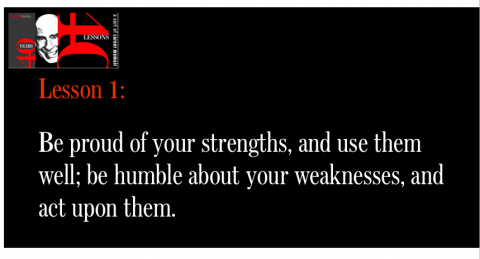
Mario in The Money Channel
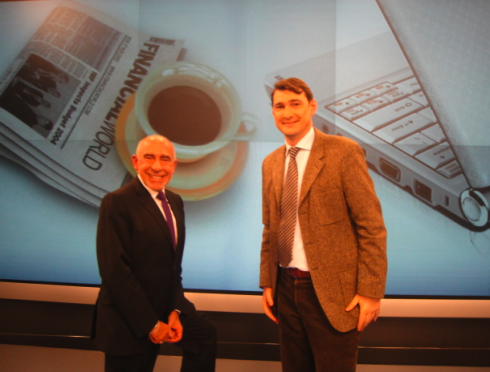
Here I pose with The Money Channel’s anchor, Daniel Apostol during live show in Bucharest Tuesday evening
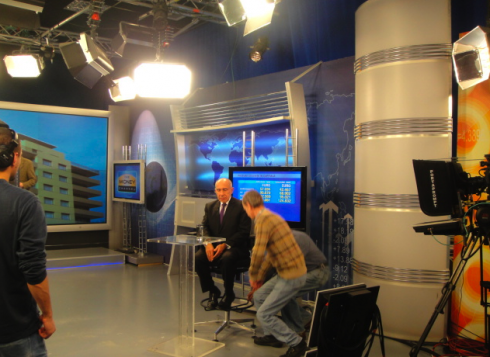
Preparing to go live on The Money Channel evening show in Romania’s TMCTV.
It is all part of setting the mood for the March unveiling of the newspaper Romania Libera’s relaunch. I was asked to appear live in the evening edition of The Money Channel’s newscast, with anchor Daniel Apostol, who shot some challenging questions. Like all journalists here, he wants to know more about how the venerable and staid Romania Libera will change.
“It is going to be dramatic, and this paper will show a little leg in its new life,” I said. “But that is just about all I would say for now. The surprises will be here soon enough in March.”
Daniel smiled and came back with one question not related to Romanian media.
“What would you do differently if you were redesigning The Wall Street Journal today?,” he asked.
Tough question, for sure. What would we do with ANY redesign we have done if we reflect and look back upon it?
I answered that many of the things I would do today have already been done since Mr. Murdoch acquired this prize title for his collection.
Here is my Bravo list for the new WSJ under Murdoch:
Photos are now part of Page One.
Headlines are bigger and more likely to seduce. The WSJ now passes the coffee table (or is that the office desk?) test with flying colors.
Content has greater appeal to younger readers and expands beyond just financial news.
Still to do:
Turn the US edition into a Berliner. That would be a dream!
Eliminate all those black rule headers from the European/Asian tabloid editions. They are funereal, too downmarket and don’t give the publication a look of class.
Revamp the US weekend edition. Dorothy, we are not in 1992 anymore.
And, yes, while at it, decide on a color palette. Right now the US editions fluctuate between early Carmen Miranda and happy Dolly Parton. The WSJ is truly neither.
(Of course, I did not mention any of this during my The Money Channel live interview. But I could not resist my early morning meditations on one of my favorite newspaper projects ever).
Charging for Online Content: new software
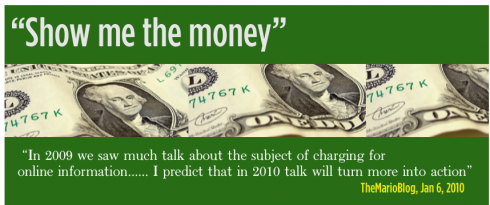
In our effort to continue to highlight stories that reassure us that this is the Show Me the Money year for the media, we recommend this piece from The New York Times. Coincidentally, it mentions the firm of Gordon Crovitz, former publisher The Wall Street Journal, with whom I had the pleasure of working when we did the 2007 relaunch of that title in narrower web format. Gordon and his partners at Journalism Online have developed a software system which they are calling Press+. Already The Intelligencer Journal-Lancaster New Era is preparing to use the software. Others interested include The Fayetteville Observer in North Carolina and GlobalPost, a news site based in Boston.
-Some News Outlets Ready to Try Charging Online Readers
http://www.nytimes.com/2010/02/03/business/media/03brill.html?emc=eta1
TheMarioBlog post #472